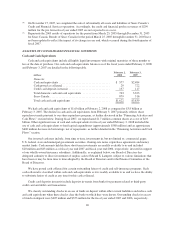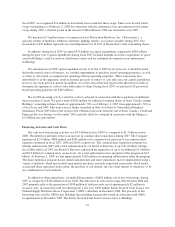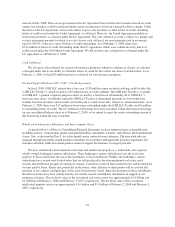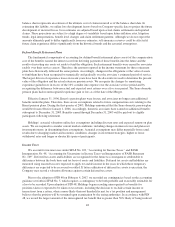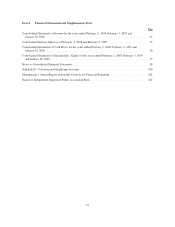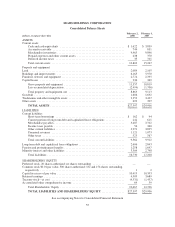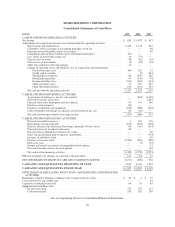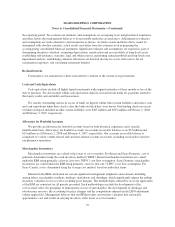Sears 2007 Annual Report Download - page 49
Download and view the complete annual report
Please find page 49 of the 2007 Sears annual report below. You can navigate through the pages in the report by either clicking on the pages listed below, or by using the keyword search tool below to find specific information within the annual report.upon settlement. Management evaluates each position based solely on the technical merits and facts and
circumstances of the position, assuming the position will be examined by a taxing authority having full
knowledge of all relevant information. Significant management judgment is required to determine whether the
recognition threshold has been met and, if so, the appropriate amount of unrecognized tax benefits to be recorded
in the Consolidated Financial Statements. Management reevaluates tax positions each period in which new
information about recognition or measurement becomes available.
Significant management judgment is required in determining our provision for income taxes, deferred tax
assets and liabilities and the valuation allowance recorded against our net deferred tax assets, if any. In assessing
the likelihood of realization of deferred tax assets, management considers estimates of the amount and character
of future taxable income. Our actual effective tax rate and income tax expense could vary from estimated
amounts due to the future impacts of various items, including changes in income tax laws, tax planning and the
Company’s forecasted financial condition and results of operations in future periods. Although management
believes current estimates are reasonable, actual results could differ from these estimates.
Domestic and foreign tax authorities periodically audit our income tax returns. These audits include
questions regarding our tax filing positions, including the timing and amount of deductions and the allocation of
income among various tax jurisdictions. In evaluating the exposures associated with our various tax filing
positions we record reserves in accordance with the provisions of FIN 48. A number of years may elapse before a
particular matter, for which we have established a reserve, is audited and fully resolved. Management’s estimates
as of the date of the financial statements reflect our best judgment giving consideration to all currently available
facts and circumstances. As such, these estimates may require adjustment in the future, as additional facts
become known or as circumstances change. For further information, see Note 14 of Notes to Consolidated
Financial Statements.
New Accounting Pronouncements
In December 2007, the FASB issued SFAS No. 141(R), “Business Combinations” which revised SFAS
No. 141, “Business Combinations”. SFAS No. 141(R) is effective for fiscal years beginning on or after
December 15, 2008, with early adoption prohibited. SFAS No. 141(R) will have a significant impact on the
accounting for transaction costs, restructuring costs as well as the initial recognition of contingent assets and
liabilities assumed during a business combination. The provisions of SFAS No. 141(R) are applied prospectively
from the date of adoption, except for adjustments to a previously acquired entity’s deferred tax assets and
uncertain tax position balances occurring outside the measurement period, which are recorded as a component of
income tax expense in the period of adjustment, rather than goodwill. We have not yet assessed the impact this
statement will have on our financial statements.
In September 2006, the FASB issued SFAS No. 157, “Fair Value Measurements.” SFAS No. 157 defines
fair value, establishes a framework for measuring fair value in generally accepted accounting principles and
expands disclosures about fair value measurements. This Statement applies under other accounting
pronouncements that require or permit fair value measurements, the FASB having previously concluded in those
accounting pronouncements that fair value is the relevant measurement attribute. Accordingly, this Statement
does not require any new fair value measurements. SFAS No. 157 is effective for fiscal years beginning after
November 15, 2007 for financial assets and liabilities, as well as nonfinancial assets and liabilities that are
recognized or disclosed at fair value in the financial statements on an annual or more frequently recurring basis.
In November 2007, the FASB provided a one year deferral for the implementation of SFAS No. 157 for
nonfinancial assets and liabilities recognized or disclosed at fair value in the financial statements on a
nonrecurring basis. We plan to adopt SFAS No. 157 beginning in the first quarter of fiscal 2008. Although we
continue to evaluate the impact the adoption of SFAS No. 157 will have on our financial statements, we do not
currently believe adoption will have a material impact on our financial condition or operating results.
In September 2006, the FASB issued SFAS No. 158, “Employer’s Accounting for Defined Benefit Pension
and Other Postretirement Plans,” which changes the recognition and disclosure provisions and measurement date
49



